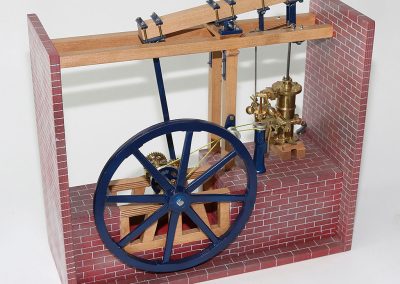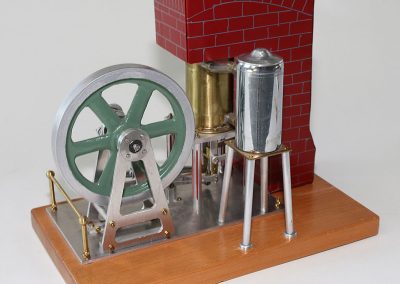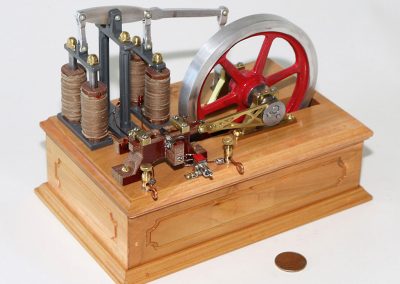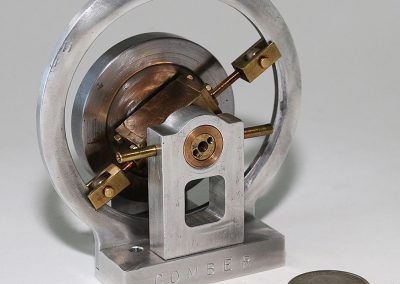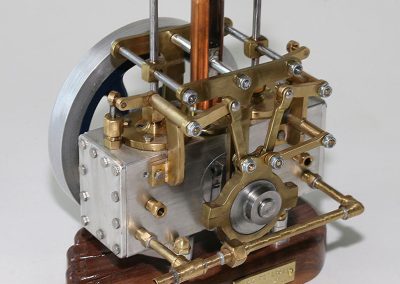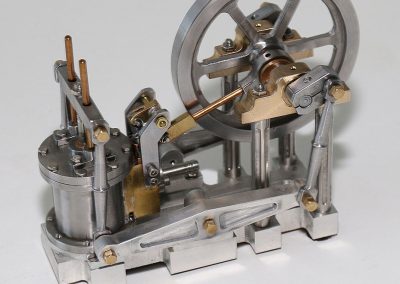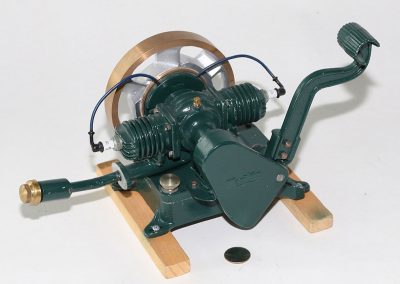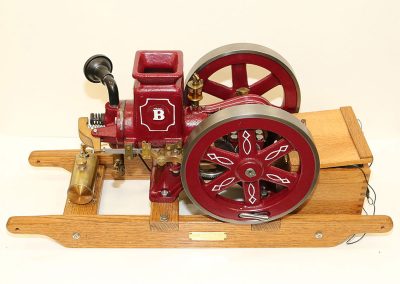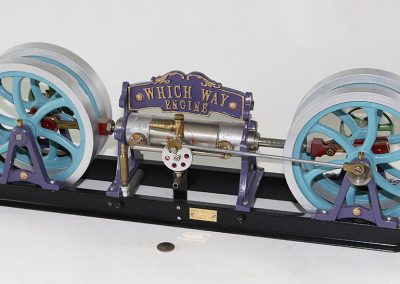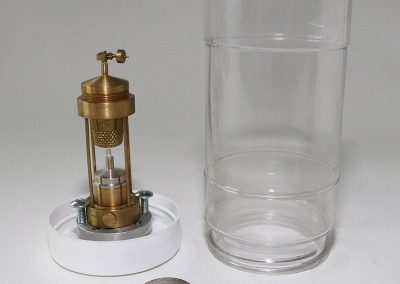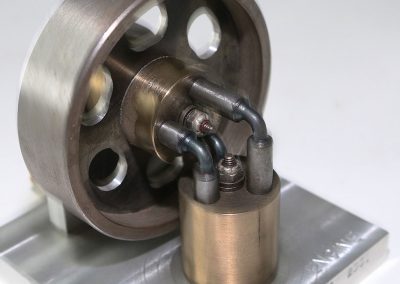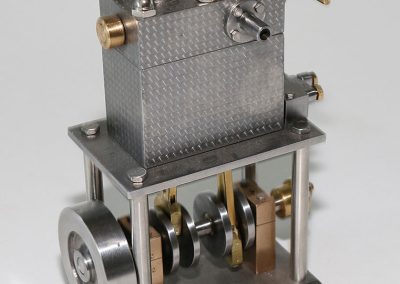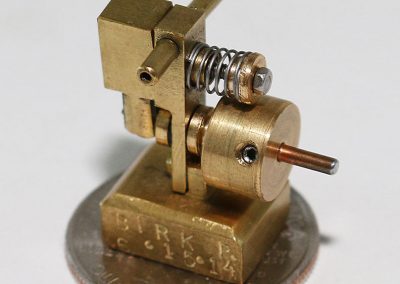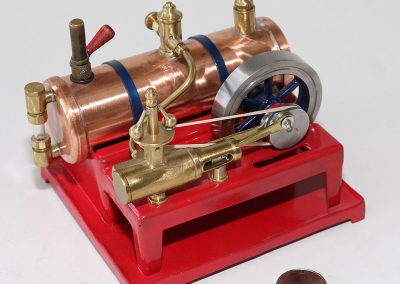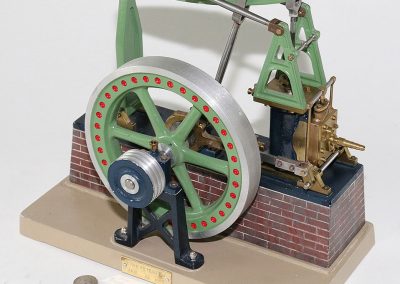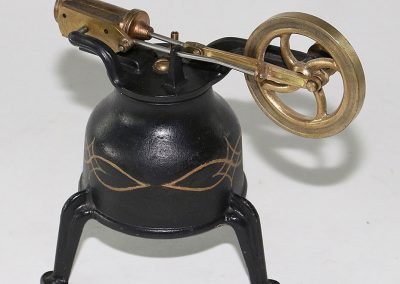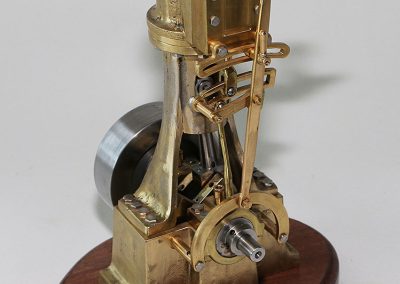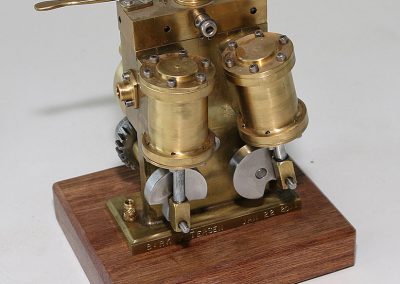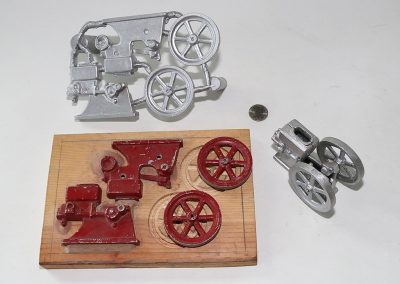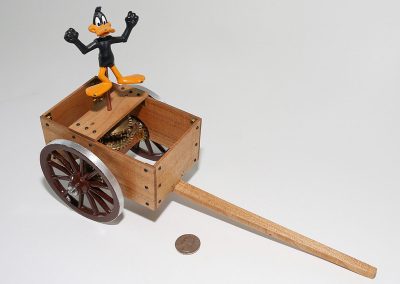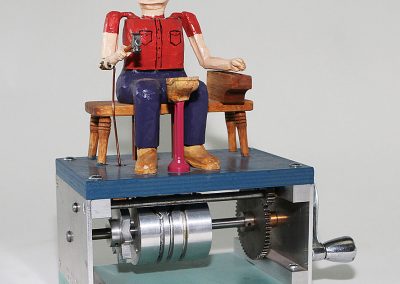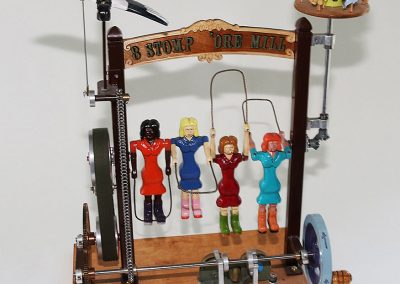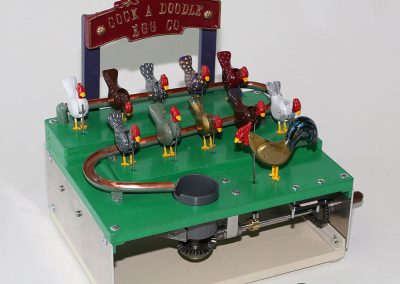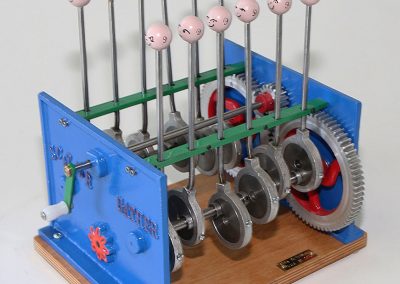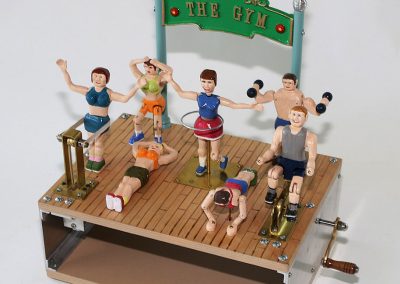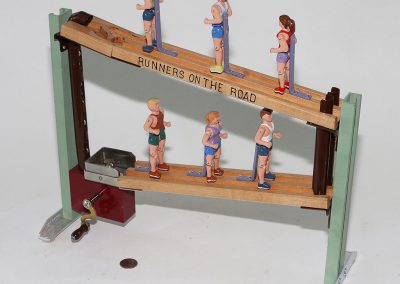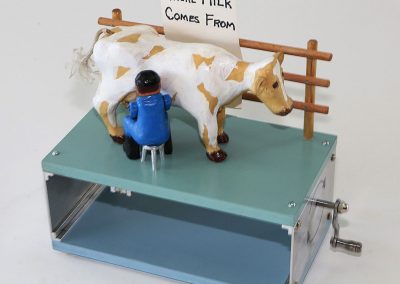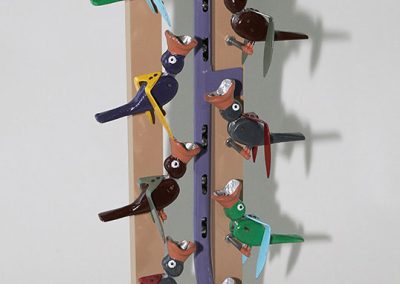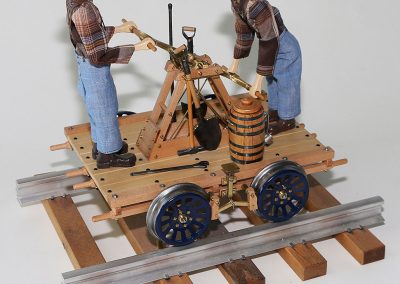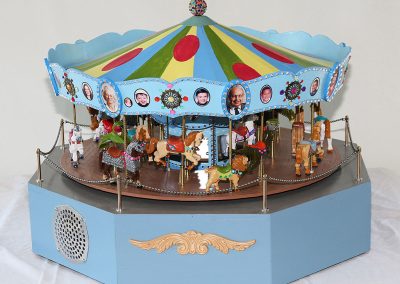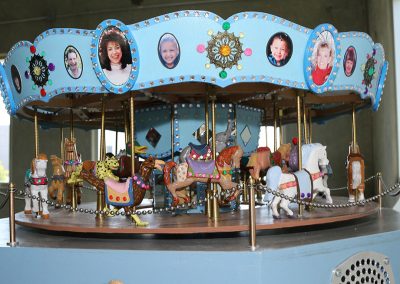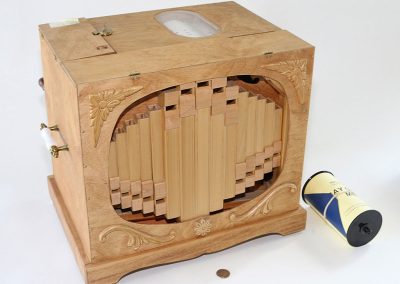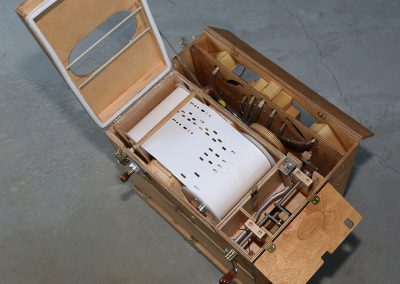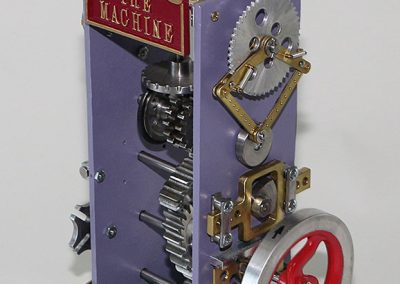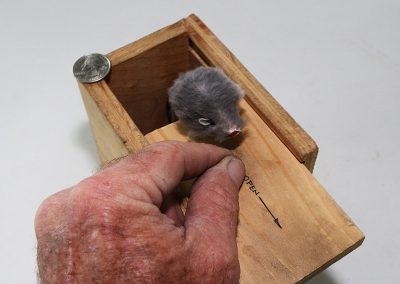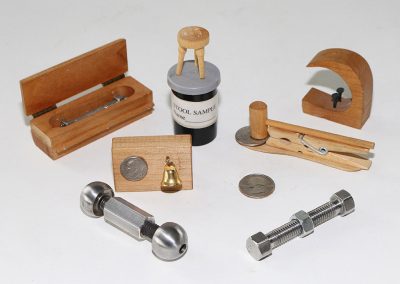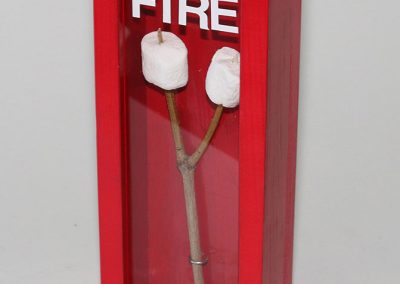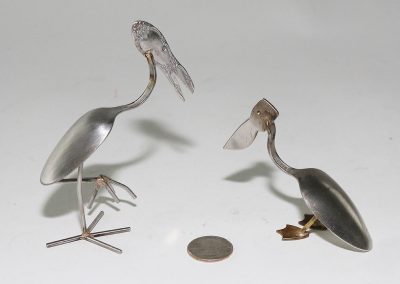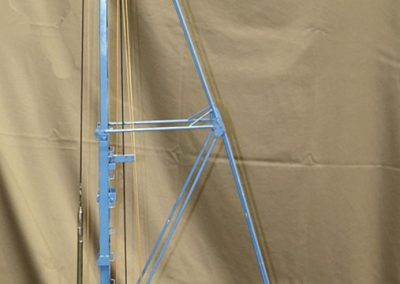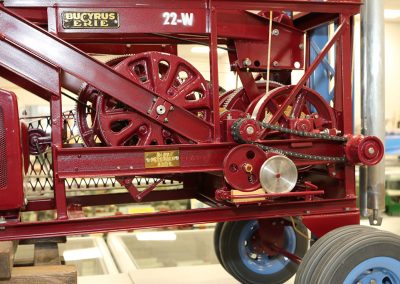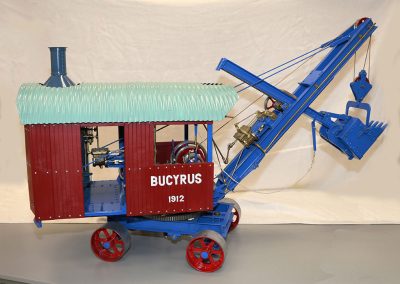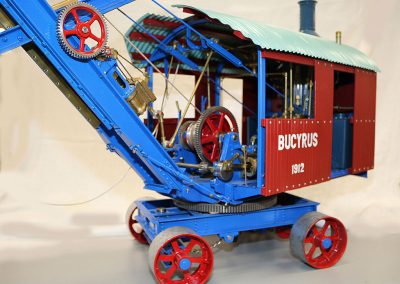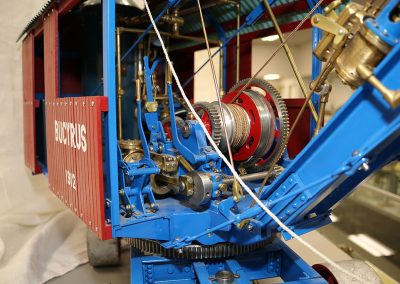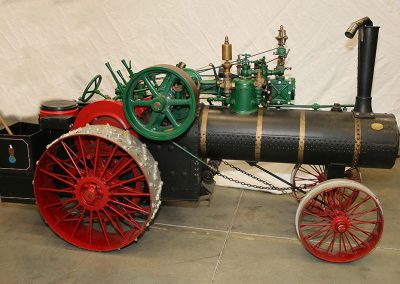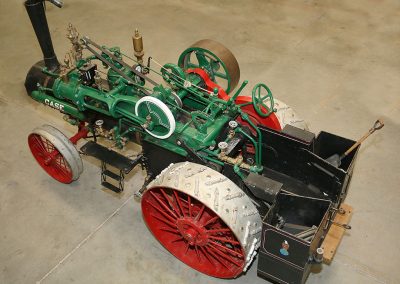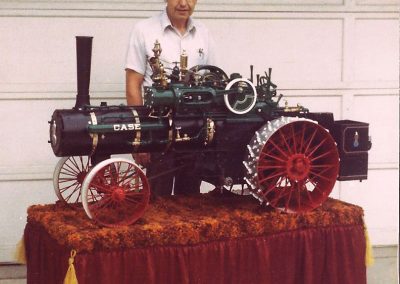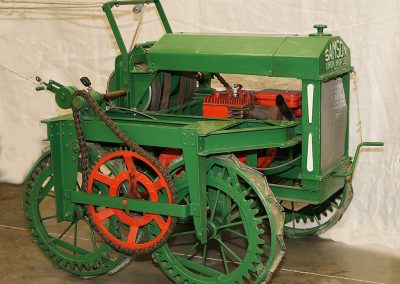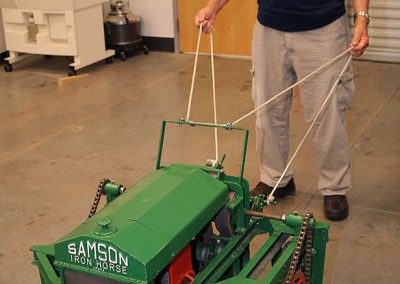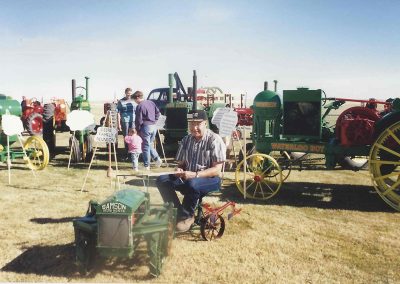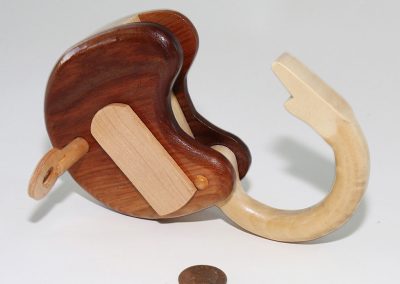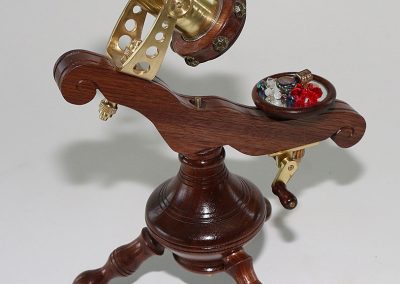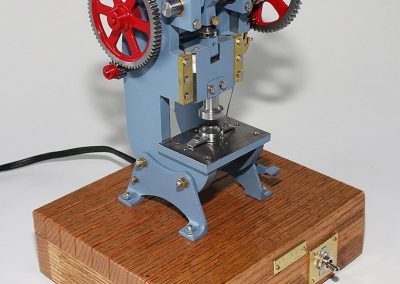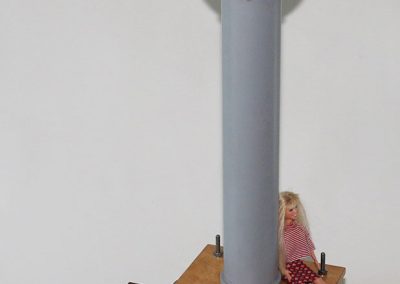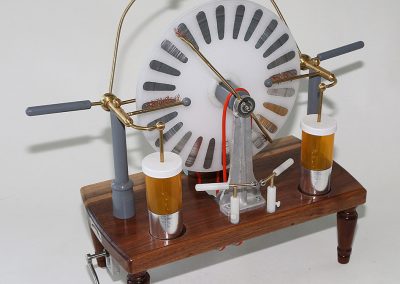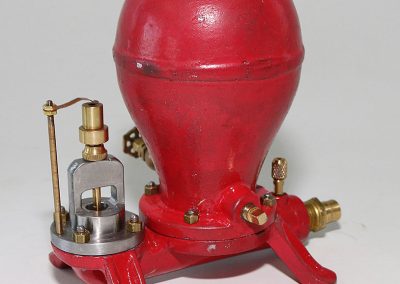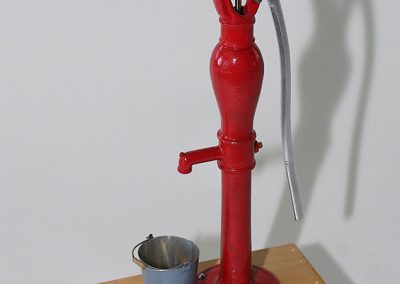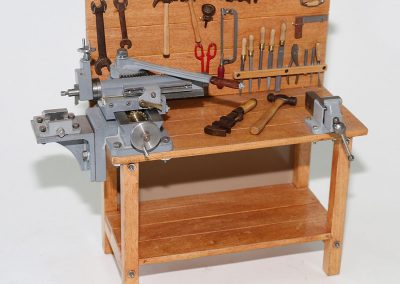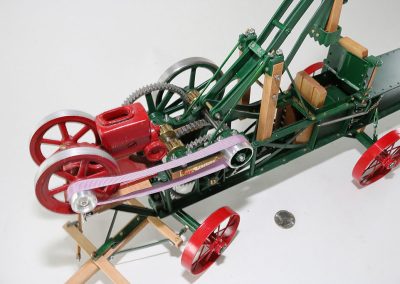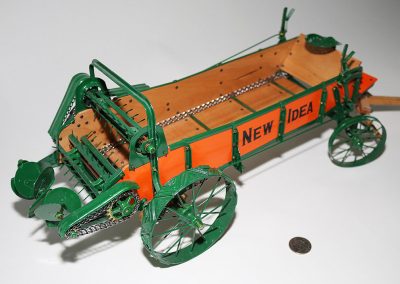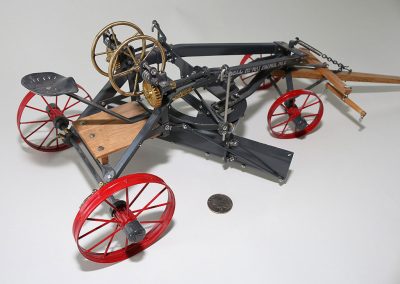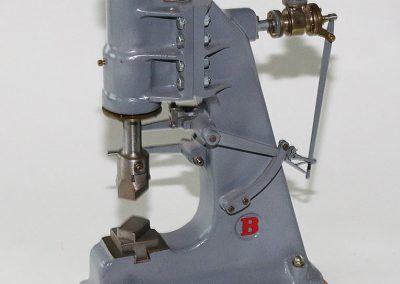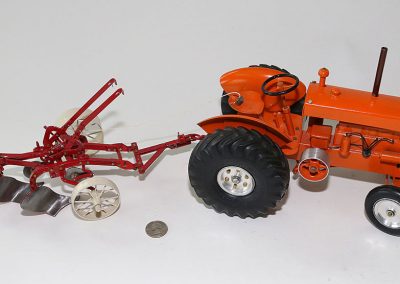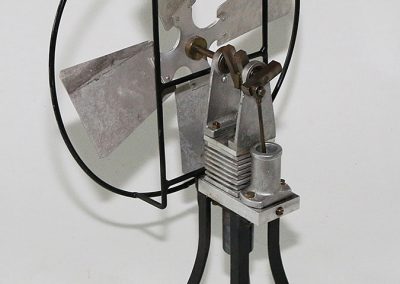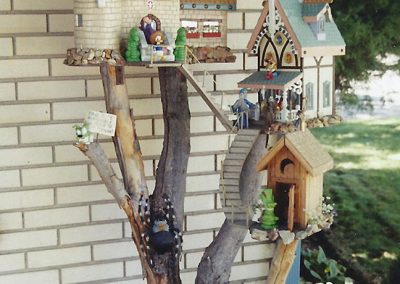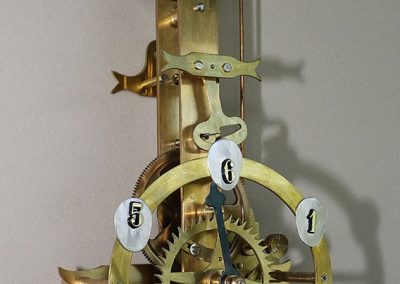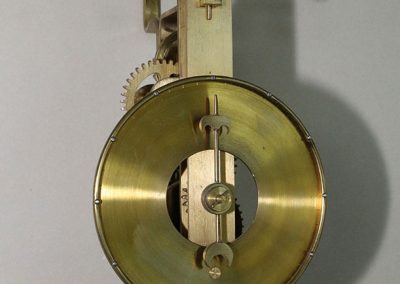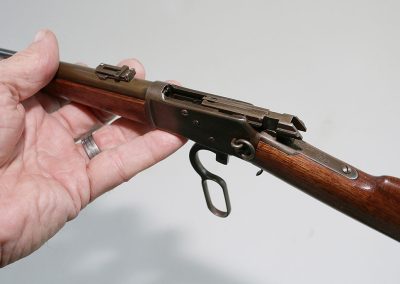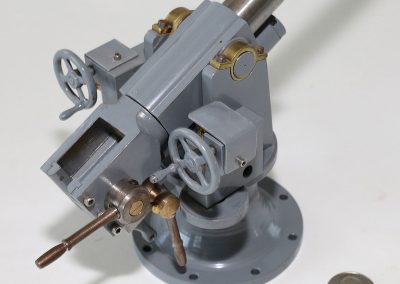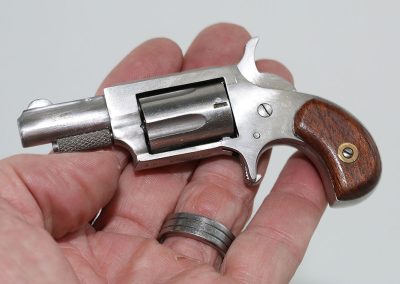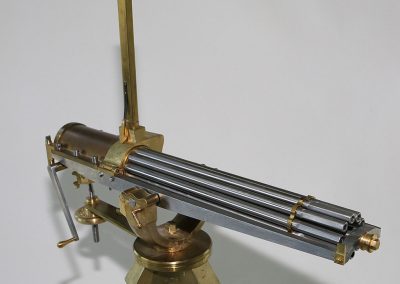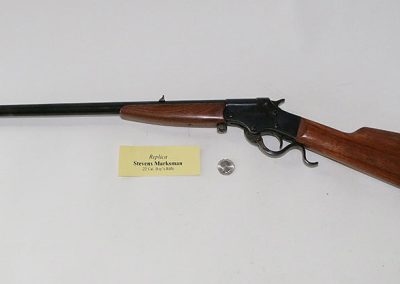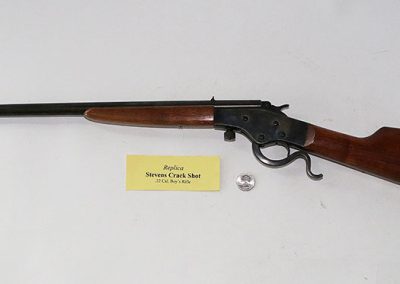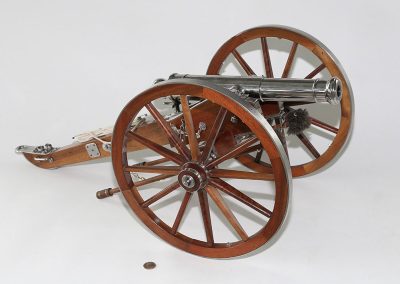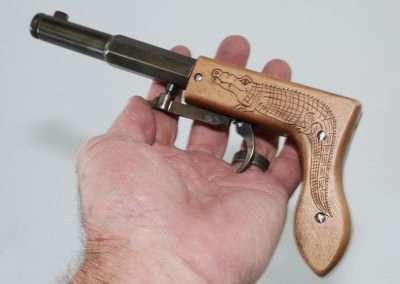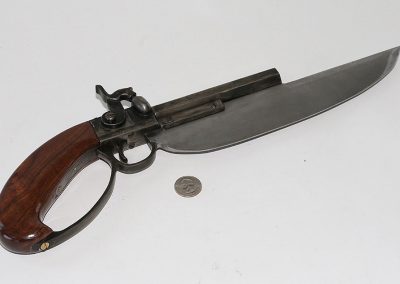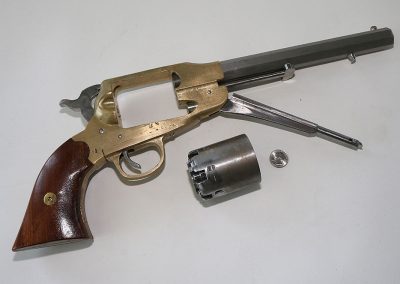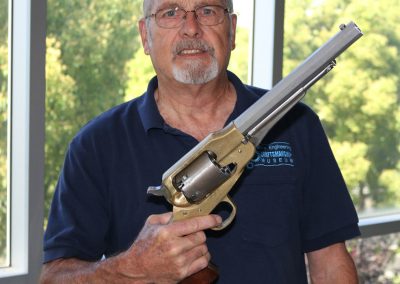Below you can view more photos of Birk Petersen’s wonderful creations. Click on images to enlarge.
Model Engines
James Watt’s Beam Engine Model
The Watt steam engine was the first type of steam engine to make use of a separate condenser. It was a vacuum (or atmospheric) engine that used steam at a pressure just above atmospheric to create a partial vacuum beneath the piston. The difference between the atmospheric pressure above the piston and the partial vacuum below it would drive the piston down the cylinder. James Watt avoided the use of high pressure steam because of safety concerns. The Watt steam engine was an improvement on the design of the Newcomen engine, and was a key part of the Industrial Revolution. Watt’s two most important improvements were the separate condenser and the use of rotary motion.
Stirling’s First Engine
The Stirling heat cycle engine was invented by Robert Stirling, a Scottish minister. It was originally conceived in 1816 as an industrial prime mover to rival the steam engine. However, its practical use was largely confined to low power domestic applications for over a century. Stirling engines have a high efficiency compared to steam engines, being able to reach 50% efficiency. They are also remarkably quiet, and can use almost any heat source. The heat energy source is generated external to the Stirling engine, rather than internal combustion. Though Stirling engines have been built in many configurations over the centuries, this model duplicates Stirling’s first design.
Bourbouze Beam Engine
Birk’s model Bourbouze beam engine (magnetic coil engine). In 1845, one industrious entrepreneur by the name of Bourbouze wanted to capitalize on the electric coil solenoid effect in a grand manner. He envisioned solenoid driven crankshaft engines powered by rooms full of batteries as an alternative to steam power. Bourbouze removed the cylinder, piston and valve system from a steam engine, and replaced them with a large electric coil, a plunger, and a switch arrangement for timing. The engine worked, but there wasn’t enough sulfuric acid and zinc available for the batteries to meet power needs—at least not compared to coal. So, like many early ideas and inventions, the electromagnetic engine was short lived.
Comber Rotary Engine
Birk noted in his blog, “After working on it since the first part of September, on the 16th I completed a model of a Comber rotary engine using plans taken from the book ‘Elmer’s Engines.’ Although it would spin free and easy when turned by hand, it refused to even try to run when air pressure was applied—even up to 120 psi. Needless to say I was quite disappointed.” His friend Mike Nay did some research, along with some other peers who had experienced the same problem. Birk ended up rebuilding part of the engine to increase the cylinder bore by 1/16”, and reduce the rotary valve by 3/16” diameter. That change made all the difference. It ran on almost no air pressure at all.
Joseph Bernay’s Steam Engine of 1878
Birk noted that most instructions for building steam engines state that they should be placed on a heavy footing or base. Birk took that literally, and mounted this Joseph Bernay steam engine to a carved wooden foot! Made in 1878, this two-cylinder engine is unique in that the crank rocks the triangular connecting rod back and forth, allowing no dead point in the rotation.
“Little Eric Nordevall” Steam Engine
In August 1836, the paddlewheel steam boat, Eric Nordevall was launched in Sweden. The boat was towed to Motala Verkstad where the steam engines and paddle wheels were installed. The steam engines were a side lever design, and produced 17 hp each. Birk made this model of the steam engine used on the ship.
Maytag Wash Machine Engine
While early wash machines on farms were often driven by a gas powered hit-n-miss engine, Maytag developed a compact kick-start engine for its wash machines. Crude by today’s standards, it was a welcome advance at the time. Birk did all the castings and machining on this model wash machine engine, and even accurately duplicated the Maytag logo in the castings. The Craftsmanship Museum also has a complete set of Birk’s mechanical drawings for this engine on file.
Olds Hit-N-Miss Engine
Hit-n-miss engines were popular on the farm before electricity was commonly available. They were workhorse engines that drove everything from pumps to wash machines. The castings for this model hit-n-miss engine were done by Paul Breisch, and Birk did all of the machining and assembly.
Which Way Engine
Birk called this creation the “Which Way Engine.” On this unusual engine, two pairs of flywheels at either end are driven by two pistons operating opposed to each other in a single cylinder. Because of the way they are connected, one flywheel will turn constantly in one direction, while the other flywheel can rotate either way.
Thimble Steam Engine
This is the smallest engine that Birk made. The oscillating micro steam engine itself sits atop a boiler made from a sewing thimble. Under that is a tiny alcohol burner to boil water for the steam. The entire steam plant is mounted to the lid of a plastic pill container.
Elbow Engine
An elbow engine is a piston-based engine typically fed by steam or compressed air. It’s based on a mechanism known as Hobson’s joint. Although not commonly used for practical purposes today, elbow engines are still built by hobbyists for their unusual motion.
Marine Steam Engine
The first engine that Birk built in 2012 was this small marine type steam engine. It was built from plans in a 1961 issue of Popular Science magazine. Birk put a nice engine-turned finish on the block to give it a special craftsman’s touch.
Mini Steam Engine
Birk’s mini steam engine is photographed sitting atop a US quarter to show its extremely small size. The brass engine is the second smallest of Birk’s steam projects.
Mini Weed Engine
This is a 2/3 scale version of a vintage toy model steam engine that was produced by Weeden.
Grasshopper Half Beam Engine
This Grasshopper steam engine get its name from the beam that goes up and down to drive the flywheel. The motion looks much like a grasshopper’s legs.
Frisbee Toy Engine Replica
This small scale engine was modeled after the J&E Stevens Frisbee toy engine. Birk made all of his own castings.
Casting Samples
The components displayed here demonstrate several casting processes. Included is the pattern board, patterns and a raw casting set made from the patterns. On the right is a small partially assembled steam engine that was made from the castings. Birk mastered every stage of the casting process.
Mechanical Toys and Animations
South-Pointing Chariot
The south-pointing chariot was designed in ancient China. A set of gears attached to each wheel measures the differential in wheel travel when the chariot turns. The figure on top is set to point south at the beginning of the journey. On roads with a decent surface, the gears will always keep the figure pointing south. Birk injected his typical sense of humor by replacing the figure of a pointing emperor with Daffy Duck.
The Shoemaker
This animated figure is called, “The Shoemaker.” When the crank on the right is turned, the figure grabs a nail, moves it to the shoe, and pounds it in. His head turns, too. All movements are controlled by the rotating grooved barrel under the floor. This is just one of many animated figures that Birk hand carved.
8 Stomp ‘Ore Mill
This piece is entitled, “8 Stomp ‘Ore Mill,” and it features four figures jumping rope. Two bells are rung with each turn of the handwheel. On the top, a bird flies on the left side while a small carousel turns on the right. Birk made all the castings and carved the figures himself.
The Cock a Doodle Egg Company
This animated farm scene is activated by turning a handle on the right side. When activated, a stream of “eggs” (steel balls) start rolling down the rows of chickens, which bob their heads up and down. The eggs are collected in a basket and then recirculated as the handle is cranked.
Scatter Gather
This piece entitled, “Scatter Gather” has an interesting set of cams that go to work when the hand crank is turned. The 12 faces start out in a straight line. As the handle is turned, they move out of alignment to form a unique pattern. The faces eventually come back into perfect alignment as the crank is continuously turned.
The Gym
Seven hand-carved wooden figures go about various exercise routines when the hand crank is turned on this piece. One character wiggles on a motorized “fat shaker” while the others do sit-ups, push-ups, weight lifting, and hula hooping. Underneath, a clever series of rods on cams drive the momentum above.
Runners on the Road
Cranking the handle on this toy raises the steel balls up a chute to the top. Then the balls run down tracks beneath the wooden runners’ feet, making them appear to run in place. A shuttle at the top of the run causes the balls to run in alternating chutes, moving the runners’ legs left and right.
Where Milk Comes From
This animated, hand-cranked toy features a farmer milking a cow. When you turn the crank, the farmer milks while the cow wags its tail. Birk hand lettered the sign on the fence.
Egg Drop Soup
Birk designed this toy, called “Egg Drop Soup,” and cast the birds himself. The crank raises a tube full of steel balls from bottom to top, and then lets one at a time fall into the first bird’s mouth. The weight causes the bird to bend over, passing the ball to the mouth of the bird below. After being passed by each bird, the ball is returned to the soup cup where it’s recycled back to the top. It’s quite a joy to see the balls being passed from colorful bird to bird.
Railroad Section Car
Often called a hand car, this model actually drives the wheels when the two carved railroad workers pump the handles up and down. This was a way for railroad workers to inspect or repair track without having to walk long distances. It could be run onto a siding, or carried off the track by two strong workers if a train was coming.
Carousel
This large 24” diameter carousel plays music, lights up, and rotates while the carved figures move up and down just like the real thing. The carousel was actually invented so that mounted French cavalry soldiers could practice riding while battling straw-filled mannequins on the ground with their swords. But they soon became a favorite ride at circuses and fairs.
Carousel
Birk’s model is personalized with photos of his whole family around the outside of the upper facade. Volume and choice of music are operated from a wireless remote—a modern touch for an antique attraction.
Box Organ
Birk carved each of the whistles and made the pump diaphragm for this hand-cranked organ. Air is pumped through holes in a rotating roll of paper, like a player piano roll that is hand cranked.
Box Organ
The sheet roll can be seen inside of the box organ here. The holes allow air to flow through varying lengths of tuned whistles, playing a song. It has the circus sound of a steam powered calliope.
The Machine
This hand-cranked mechanism, titled simply “The Machine,” demonstrates just about every kind of geared motion you could imagine—and some you can’t! Inside are offset gears canted at an angle to each other, yet they still mesh perfectly as they turn. The main shafts are driven by the main gears, and they power all sorts of continuous and intermittent motion on each side of the case. They also power the flyball regulator on top. With all of these interrelated gear connections, the crank could become difficult or impossible to turn if any one piece was engineered poorly. However, Birk’s machine turns smoothly at all positions.
Mousie Surprise
Another one of Birk’s more creative projects is called, “Mousie Surprise.” If you follow the instructions on the case and pull back the lid using the tiny handle, a furry mouse pops out of the box to nibble on your finger!
Joke Toys
Birk loved a good pun, and went as far as to illustrate some through small models like these. From the upper left going clockwise these pieces are titled: “Dead Bolt,” “Stool Sample,” “Tax Shelter,” “Quarter Pounder,” two different “two-headed bolt puzzles,” and “Dime and Ring.”
Fire Code
Entitled “Fire Code,” Birk developed this tongue-in-cheek emergency device to be used in case of fire. Just break the glass and toast two marshmallows. This is a perfect illustration of Birk’s sense of humor woven into his projects.
Model Machines, Tools, and Other Miniatures
Bucyrus-Erie 22W Well Drilling Rig
A scale model Bucyrus-Erie 22W well drilling machine. Birk took dimensions for this working model from a full-size version that his neighbor owned. He made a second model for the neighbor as well.
Bucyrus-Erie 22W Well Drilling Rig
This machine doesn’t actually turn a drill bit. Instead, it repeatedly raises and drops a heavy rod to pulverize the rock and dirt in the shaft. Then, water is pumped in and the slurry is withdrawn. This method of drilling goes back to Roman times.
Bucyrus Steam Shovel Model
Birk’s operational model of a Bucyrus steam shovel. The original was built in 1912.
Bucyrus Steam Shovel Model
Birk’s model was used to dispense candy from the bucket into the hands of visiting neighborhood children.
Bucyrus Steam Shovel Model
A close-up view of some of the mechanical components for the steam shovel.
1/4 Scale Case 65 hp Steam Tractor
Birk completed this 1/4 scale Case 65 hp steam tractor in 1982. The boiler was tested to 475 psi. It took over three years to build.
1/4 Scale Case Steam Tractor
Birk started with a set of castings and plans, and proceeded to do all the machining, assembly, and painting himself.
1/2 Scale 1919 Samson “Iron Horse” Tractor
Birk’s 1/2 scale 1919 Samson “Iron Horse” tractor. The model was based on a prototype that was owned by Bill Oester of Scappoose, OR. Samsons were built by General Motors Corporation, and powered by a 490 cubic inch Chevy engine. (Birk’s model is powered by a lawn mower engine.)
1/2 scale 1919 Samson “Iron Horse” Tractor
The prototype that Birk measured for this model is one of only four known to exist. The Iron Horse tractor was an early attempt to ease the fear of farmers who were used to walking behind a team of horses for farm work. It was operated by a set of reins that were pulled to steer the tractor. At the time, the tractors were less costly than a team of three horses, but reliability problems led to poor sales.
1/2 scale 1919 Samson “Iron Horse” Tractor
Birk rides behind his scale Iron Horse tractor at a show on a small trailer that he built to resemble a plow.
Wooden Padlock
This project duplicates the function of a key-locked padlock in wood. It is about 4” wide.
Kaleidoscope
This kaleidoscope uses a prism lens to segment the viewing area into repeating patterns. Colored objects on the target surface change patterns as the lens is turned. Birk’s ornate version was made from wood and brass.
Miniature Punch Press
A small model of an industrial punch press that was used to press metal into shapes over a die or cut them out. This tiny electrically powered press actually works to form metal.
Van de Graaff Generator
Static electricity generated by this machine will literally cause your hair to stand on end. It’s an electrostatic generator that uses a moving belt to accumulate electric charge on a hollow metal globe on the top of an insulated column. This creates very high electric potential. The generator produces very high voltage direct current (DC) electricity at low current levels. It was invented by American physicist Robert J. Van de Graaff in 1929. The potential difference achieved in modern Van de Graaff generators can reach 5 megavolts. A tabletop version like this can produce on the order of 100,000 volts, and can store enough energy to produce a visible spark.
Wimshurst Generator
The Wimshurst influence machine is an electrostatic generator that was developed between 1880-1883 by British inventor James Wimshurst. It has a distinctive appearance with two large contra-rotating discs mounted in a vertical plane. It also has two crossed bars with metallic brushes, and a spark gap formed by two metal spheres. Versions of this machine often appeared in early science fiction movies, typically in the lab of some mad scientist, and often generating impressive sparks.
Hydraulic Ram Pump
Birk designed and cast this hydraulic ram pump. This pump uses a clever method to raise water to a higher elevation by using the weight of the water itself. A portion of the water is spilled in the process, but if you have a plentiful source then it’s not a problem. The first self-acting ram pump was invented by the Frenchman Joseph-Michel Montgolfier (best known as a co-inventor of the hot air balloon). Mr. Montgolfier built the ram pump in 1796 for raising water in his paper mill at Voiron.
Hand Operated Water Pump
Birk’s scale model hand operated water pump. This kind of pump would have likely been found on a farm, pumping water from a well. Birk also made an electric powered pump that is on display at the Craftsmanship Museum alongside this one.
Miniature Workbench and Tools
This tiny wooden workbench features a hand operated metal shaper attached to the bench top. This was an early form of milling machine. A vise is attached to the right side of the bench. The back of the bench contains a host of small handmade tools, including an auger drill, hammer, wrenches, chisels, screwdrivers, pliers, and more.
Ann Arbor Hay Press
This model represents a piece of farm equipment that was used to scoop up hay and compress it into bales. Birk’s small Ann Arbor hay press duplicates all the functions of the real horse-drawn machine.
Steam Hammer
This heavy duty miniature is a model steam hammer that would have been used in a factory for pounding metal into shape. Birk started this model with raw castings that were made by Paul Breisch.
Stirling Powered Fan
Before electricity was commonly available in rural areas, there was no air conditioning or even many fans to keep cool. The invention of the Stirling engine changed that. Using the heat differential from one part of the engine to another, just a candle flame was sufficient to turn a fan.
Yard Art
Not all of Birk’s projects involved machining. He also liked to build sculptures for decoration in his yard. These included odd animals, wind-activated sculptures, garden decor, and the “troll houses” shown here.
Egg Timer
This brass geared clock is powered by gravity. It was designed to act like a stopwatch for cooking hard-boiled eggs. It can be set from 1-6 minutes. The pendulum counts down the time until the end of the period, at which point it rings a bell.
Full-Size and Scale Model Firearms
1/2 Scale Winchester Rifle (1892)
Birk’s 1/2 scale Winchester Model 1892 44-40 lever action rifle. This half-size rifle was chambered for .22 caliber rounds.
Model Naval Deck Gun
Birk modeled this Naval deck gun in .22 caliber. All of the controls to rotate and elevate the barrel are functional.
Stevens Marksman .22 Rifle
Birk built this fine replica of a Stevens “Marksman” .22 caliber boy’s rifle from scratch. It features a stock that hinges at the breech to load a single round at a time.
Stevens Crack Shot .22 Rifle
Birk also made this similar Stevens “Crack Shot” boy’s rifle replica. It features a rolling block type mechanism that allows a round to be loaded without hinging the center of the gun.
Model Artillery Cannon
Birk built this model of a field artillery cannon to a high level of accuracy. Even the wooden spoked wheels have the correct amount of spoke-to-rim offset, so they wouldn’t come off during cornering. The model cannon also includes the proper barrel cleaning and loading tools, too.
Underhammer Gator Pistol
Birk’s small underhammer Gator Pistol features an alligator carved into the wooden handle. Unlike most caplock pistol designs, this version has the hammer and percussion cap underneath the barrel, rather than over the top.
Elgin Navy Cutlass Pistol
Birk’s full-size Elgin Navy cutlass pistol. Early black powder caplock pistols took a long time to load. Soldiers basically had one shot in a pitched battle. After that, they were on their own. The Navy saw fit to design a pistol that also had a knife blade mounted to the barrel. This .54 caliber accurately duplicates the original. With this patent, Elgin combined the blade and a caplock pistol to produce a dual-purpose weapon. It was the first percussion handgun officially used by the US military, and the only knife pistol used by a military branch. There were only 150 of these pistols produced on Navy contract.
1.5 Scale Remington .66 Cal Navy Revolver
Many people build miniature guns, but who builds oversize guns? Birk Petersen supersized this old .66 caliber Remington Navy revolver to one and a half times the normal size. The revolver weighs over 12 pounds. The giant revolver is fully functional but has no firing pin.

